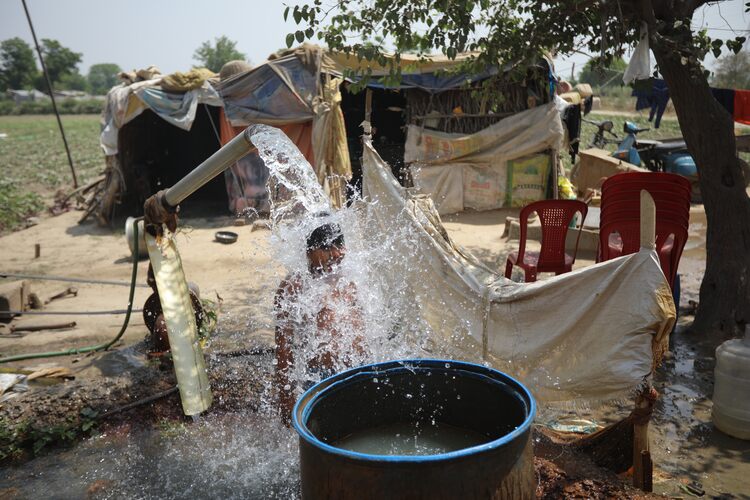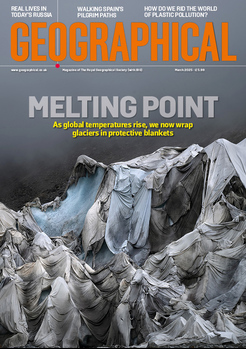
Amid rising temperatures and the hottest month globally on record, our planet may be heading for a future of ultra-heatwaves due to global warming
By
According to the UN, each decade since the 1980s has been hotter than the previous one. And if greenhouse gases continue to rise at current levels, climate models predict that the Earth’s global average temperature will rise by 4C during the 21st century.
So, if these increasing temperatures are set to continue, what does this hold for the future of Earth? Will we eventually hit scorching temperatures of 60C – and if so, what effect do these temperatures have on our planet?
Ultra-heatwaves in MENA region
The recent announcement of an El Niño event last month – which can last between nine to twelve months as Pacific Ocean trade winds slow – is yet another factor which causes global warming. Increasing temperatures will affect regions differently – with temperatures predicted to be higher on land than over oceans, and greater at high latitudes compared to mid-latitudes and the tropics.
In a study published in Nature, researchers found that if we continue on a ‘business-as-usual’ path, super- and ultra-extreme heatwave conditions – temperatures of up to 56C and higher for a period of several weeks – will begin in the second half of this century in the MENA (Middle East and North Africa) region, a group of countries including Egypt, United Arab Emirates and Jordan.
Related articles

By using modelling techniques, the researchers were able to simulate the MENA climate, in order to project heatwaves and their consequences upon human health – finding that by 2100, around half of the MENA population – approximately 600 million people – would be exposed to these types of heatwaves.
Humans will suffer in these arid conditions, with heat-stroke and heat exhaustion especially prominent in the elderly and groups with pre-existing health conditions – a factor that can cause significant loss of productivity among the labour force. The researchers believe that humans will be forced to migrate away from these regions if indoor or outdoor cooling is not used.
In the modelling for high greenhouse gas emissions, areas in the Middle East – such as the Arabian Gulf – are projected to reach or even pass the threshold for human habitation, due to a combination of high temperatures and humidity.
Livestock in the MENA region, such as camel, cattle and goat, will also be affected by these heatwaves, as they are located in areas of high vulnerability.
Modelling the future of global temperatures
Last year marked the eighth year in a row that global temperatures reached at least 1C above pre-industrial levels, causing extreme weather conditions across the globe as global warming continued.
‘In 2022, we faced several dramatic weather disasters which claimed far too many lives and livelihoods and undermined health, food, energy and water security and infrastructure,’ said World Meteorological Office Secretary-General, Professor Petteri Taalas.
‘Large areas of Pakistan were flooded, with major economic losses and human casualties. Record-breaking heatwaves have been observed in China, Europe, North and South America. The long-lasting drought in the Horn of Africa threatens a humanitarian catastrophe,’ Taalas continued.
And only this month, extreme heatwaves have swept across Europe, with temperatures soaring past 40C in areas of Spain, Croatia, Greece, Turkey and France – with another heatwave, named Charon, developing this week after a large area of high-pressure building across central parts of the Mediterranean.
As much as 90 per cent of India is now classified as lying in extreme heat danger zones – which could reduce the quality of life of up to 480 million people, and cause falling productivity for the country, estimated at a loss of 5.4 per cent of its GDP.

There are also concerns that global temperatures will soon breach the 1.5ºC limit above pre-industrial levels, set out in the Paris Agreement – with the WMO advising a 50 per cent chance that the planet may cross this 1.5ºC threshold – if only temporarily – as soon as 2026. According to the World Economic Forum, if we continue on the same ‘business-as-usual’ path – in other words, emitting the same amount of greenhouse gases and emissions into the atmosphere – the 2050s may bring 2 billion people facing 60ºC temperatures for more than a month each year.
And by 2100, a study published in Science found that Southern Spain and Portugal may become deserts, causing millions to suffer from food and water scarcity – while severe drought could affect up to 40 per cent of the global population.
A study used artificial intelligence to predict that there would be an 80 per cent chance of the Earth becoming 2ºC warmer by 2060. The AI used a vast quantity of global climate model simulations to come to the conclusion.
In order to test its accuracy, the researchers asked the AI to identify the current level of global warming – 1.1ºC – based on temperature anomaly data from 1980 to 2021. The AI was able to correctly identify that the current level would be reached in 2022.
‘This was really the ‘acid test’ to see if the AI could predict the timing that we know has occurred,’ said the study’s lead author, Stanford University climate scientist Noah Diffenbaugh.
‘We were pretty sceptical that this method would work until we saw that result. The fact that the AI has such high accuracy increases my confidence in its predictions of future warming.’
Can we prevent global warming?
Despite the dire forecast for the planet, it isn’t bad news – and there is still time to prevent these predictions from coming true. If all human emissions of greenhouse gases stopped today, the Earth’s temperature would continue to rise initially – as ocean currents would bring excess heat trapped in the ocean back to the surface – but eventually stabilise as the heat radiates out to space.
Estimates suggest that this heat would contribute to a global temperature increase of 0.5ºC – but after this point, temperatures would begin to drop.
But according to the NOAA, if dramatic action is not taken, it is likely that the 1.5ºC threshold of the Paris Agreement will be exceeded – so countries must take immediate action in order to prove these models wrong.

To help reduce global warming, alternative methods known as ‘climate engineering’ or ‘geoengineering’ are being proposed – such as cooling the Earth’s surface using reflective particles in the upper atmosphere, which can reflect sunlight back into space; or ‘planting’ iron in oceans to stimulate phytoplankton blooms which can draw carbon dioxide out of the atmosphere. However, the consequences of these methods are not yet widely understood and potentially come with ethical and legal considerations which have not been fully explored.
Countries are also working on ways of lowering their emissions, by replacing coal, oil and gas with renewable energy sources, such as wind and solar – with 70 countries already setting a net-zero target, covering around 76 per cent of global emissions. Over 400 financial institutions, 1000 cities and 1000 educational institutes have joined Race to Zero, taking a pledge to act immediately to halve global emissions by 2030.
But it’s important to transform pledges into action and to ensure that net-zero greenwashing – the process of companies falsely or misleadingly claiming their part in tackling global warming – does not happen. To support this endeavour, the UN established a High-Level Expert Group in 2022 to make sure that pledges are strong, actionable and clear to consumers, investors and regulators.
The drive to lower global emissions continues, but if dramatic action is not implemented soon, we may be heading for a future of higher temperatures that bring about an unprecedented array of consequences for the planet and its inhabitants.




